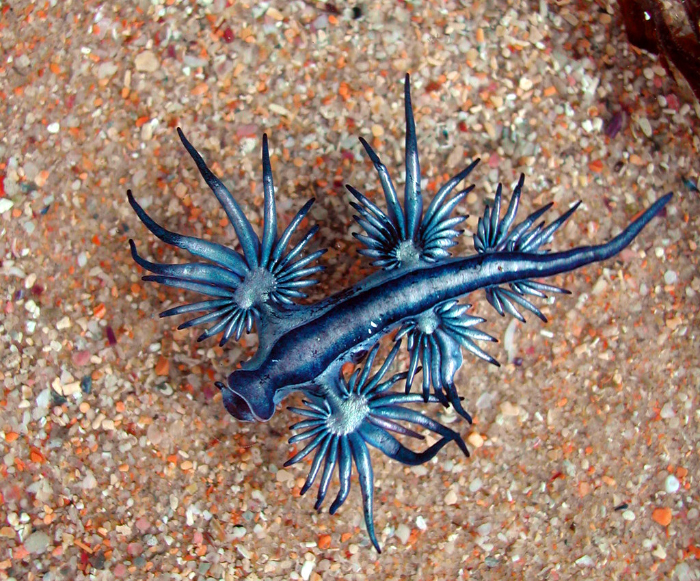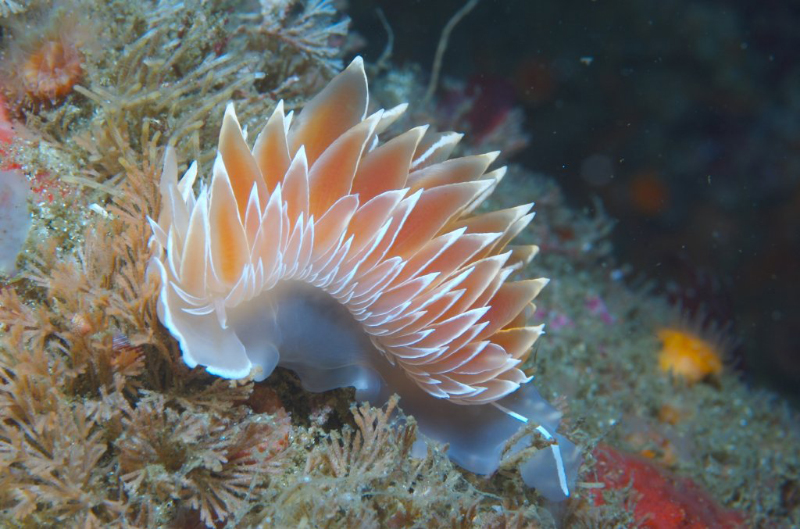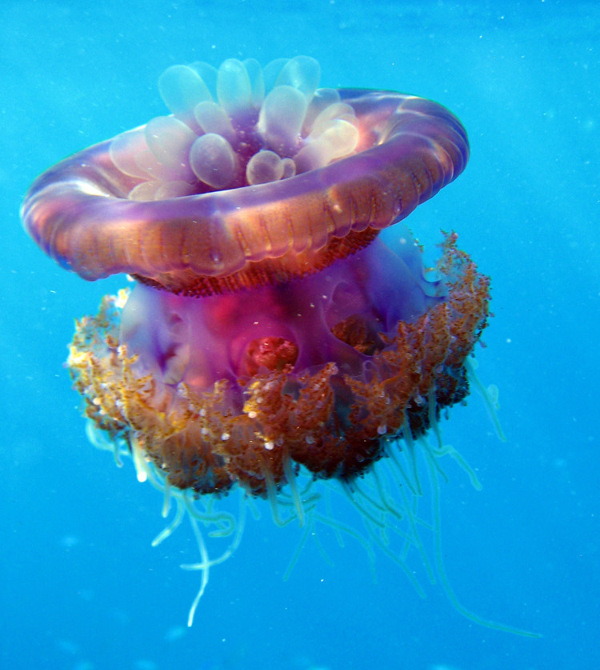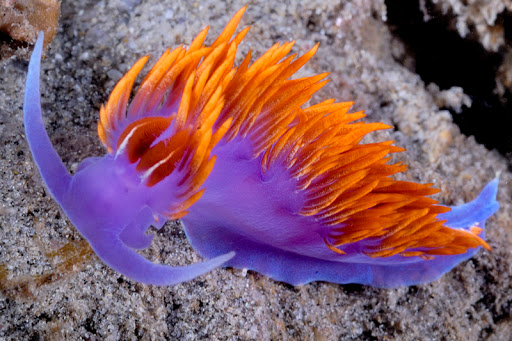It looks like you're using an Ad Blocker.
Please white-list or disable AboveTopSecret.com in your ad-blocking tool.
Thank you.
Some features of ATS will be disabled while you continue to use an ad-blocker.
22
share:
With all that's happening right now, I believe this is a good moment to post this thread(which I wanted to post for a long time now) and hopefully
get your minds distracted for a couple minutes, away from the covid19 hysteria outside but also here on ATS, where most of the new threads are about
the Corona virus. It also been a while I've seen some new Fragile Earth threads pop up.
So yeah...
Living near the sea and fascinated by it for many years since my childhood, by their inhabitants, the beauty, but also cruelty of the deep waters. Being one of the most powerful force on this planet, witnessing it many times over, I only want to share beauty for now.
Here is a list of my 'top 10' of most interesting and beautiful animals of the sea, in no particular order. It doesn't contain any fish, it's only about slugs, squids and dragons.
I hope you enjoy it and thanks for reading.
The information I added comes from books and numerous websites on the net.
Here are some of the sources used.
species-identification.org...
www.ala.org.au...
www.sealifebase.se...
oceana.org...
www.seawater.no...
www.marlin.ac.uk...
www.centralcoastbiodiversity.org...
ourmarinespecies.com...
-----
1.Comb Jellies
 The Bolinopsis infundibulum or Northern comb jelly can be found in the entire North Atlantic Ocean. They have been spotted by
remote operated vehicles at depths up to 2km as well at the surface.
The Bolinopsis infundibulum or Northern comb jelly can be found in the entire North Atlantic Ocean. They have been spotted by
remote operated vehicles at depths up to 2km as well at the surface.
The Bolinopsis infundibulum swims with eight longitudinal combs, four long rows and four short rows. These combs consist of plates of transverse rows of hairs that beat in waves downwards, which produces the shimmering effect. These plates are phosphorescent at night.
2.Glaucus atlanticus
 Glaucus atlanticus, also called sea swallow, blue dragon or blue angel is a type of sea slug. It uses an air bubble stored in
its stomach to keep it afloat, usually on its backside exposing their brightly colored belly as a camouflage against airborne predators while its
greyish backside blends in with sea surface, concealing it from predators below, also known as countershading.
Glaucus atlanticus, also called sea swallow, blue dragon or blue angel is a type of sea slug. It uses an air bubble stored in
its stomach to keep it afloat, usually on its backside exposing their brightly colored belly as a camouflage against airborne predators while its
greyish backside blends in with sea surface, concealing it from predators below, also known as countershading.
Its favorite snack is the Physalia physalis or Portuguese man o' war. When feeding, the Glaucus atlanticus collects the Portuguese man o' war’s venom in special sacs at the end of its ‘fingers’ and can use it later as a way of defend.
The stings from these small creatures are known to be more powerful than from those of the ones it collected it from.
3.Dirona Albolineata
 Dirona Albolineata another species of sea slug found in shallow waters along the Pacific coast of N-A and along coastlines of
Russia and Japan. Dirona Albolineata are carnivores that feed mostly on snails or small shrimps, crabs and other crustacean.
Dirona Albolineata another species of sea slug found in shallow waters along the Pacific coast of N-A and along coastlines of
Russia and Japan. Dirona Albolineata are carnivores that feed mostly on snails or small shrimps, crabs and other crustacean.
Just like lizards they can shed their cerata ‘fingers’ when being attacked or in danger to escape their predators.
They can lay up to millions of eggs to ensure that the young make it up to childhood, their life span ranges from 6 months to a year.
4.Glowing sucker octopus
 Stauroteuthis syrtensis, also known as the glowing sucker octopus, have been spotted in the deep oceans of the Eastern United
States to a depth of 2.5km. It’s a fairly small species growing up to 50cm, eight arms included and is the most bioluminescent octopus.
Stauroteuthis syrtensis, also known as the glowing sucker octopus, have been spotted in the deep oceans of the Eastern United
States to a depth of 2.5km. It’s a fairly small species growing up to 50cm, eight arms included and is the most bioluminescent octopus.
When stressed or attacked it will inflate its web to defend and scare predators but can also be used to attack its prey. Its arms contain photophores that can flash on and off in a unique pattern. The lights are thought to be used for predatory purposes as well as communication.
5.Weedy Sea dragon
 The weedy sea dragon is a popular species of seahorses that are often used as pets in aquariums. They mainly live in the
regions of Australia and Tasmania but are also bread throughout the world in captivity.
The weedy sea dragon is a popular species of seahorses that are often used as pets in aquariums. They mainly live in the
regions of Australia and Tasmania but are also bread throughout the world in captivity.
Although don’t have teeth, these animals are carnivorous. They use their nose or snout to suck up small fish and several types of shrimp. Special muscles in the snout can widen it to capture different sizes of food. Adults can grow to 45cm and live up to 10 years in the wild.
6.Sea Angels, Clione limacina
 Sea angles are small translucent, shell-less pelagic sea slugs in the Gymnosomata group.
Sea angles are small translucent, shell-less pelagic sea slugs in the Gymnosomata group.
The Clione limacine or naked sea butterfly is a pteropod that lives at a depth of up to 500m in the colder regions of the Atlantic and Artic Ocean. They are small 20-25mm slugs that uses their two ‘fins’ to move through the water. The slug does not have gills to breath but uses its gelatinous skin to extract oxygen from the water. They can occur in large numbers and is an important food sources for fish and whales, in particular the Balaena mysticetus or bowhead whale.
Norwegian whalers call these species ‘krill’.
7.crown of thorns starfish
 Acanthaster planci, coral-eating starfish or crown-of-thorns sea star can be found in coral reefs from the western Indian
Ocean to the Red Sea, across the Pacific and the west coast of America.
Acanthaster planci, coral-eating starfish or crown-of-thorns sea star can be found in coral reefs from the western Indian
Ocean to the Red Sea, across the Pacific and the west coast of America.
Adults primarily feeds on coral, they are also called a corallivore. No other animal feeds on coral so efficiently as the Acanthaster planci.
It spends about half of its time on feeding and can crawl at the rate of up to 35cm/min over coral reefs and rubble.
8.Cauliflower jellyfish
 Cephea cephea, also known as the crown jellyfish or cauliflower jellyfish and is found in the open waters of the Indo-Pacific
and East Atlantic Ocean. It got its name from the cauliflower-looking crown at the top. The Cauliflower Jellyfish is targeted by the Chinese and
Japanese fishing industry where it is consumed as delicacy or used for medicinal purposes.
Cephea cephea, also known as the crown jellyfish or cauliflower jellyfish and is found in the open waters of the Indo-Pacific
and East Atlantic Ocean. It got its name from the cauliflower-looking crown at the top. The Cauliflower Jellyfish is targeted by the Chinese and
Japanese fishing industry where it is consumed as delicacy or used for medicinal purposes.
9.Firefly Squid

 Watasenia scintillans or firefly squid are small bioluminescent creatures that live in the Western
Pacific Ocean, they are often found in deep waters surrounding the coastline of Japan. During the day they mostly live in the deep ocean but during
the night they can be seen at the surface and near the shores in search for food. They use their photophores to produce a blue neon like effect which
is used to attract prey and to communicate. Several months a year they can be seen in a ‘not to miss light show’ near the shores when they gather
to fertilize and drop their eggs.
Watasenia scintillans or firefly squid are small bioluminescent creatures that live in the Western
Pacific Ocean, they are often found in deep waters surrounding the coastline of Japan. During the day they mostly live in the deep ocean but during
the night they can be seen at the surface and near the shores in search for food. They use their photophores to produce a blue neon like effect which
is used to attract prey and to communicate. Several months a year they can be seen in a ‘not to miss light show’ near the shores when they gather
to fertilize and drop their eggs.
10.Blanket Octopus

 Tremoctopus gracilis, blanket octopus is a large cephalopod which spends
Tremoctopus gracilis, blanket octopus is a large cephalopod which spends
its entire life in the open ocean from the Indian to the Pacific Ocean.
Males and females Tremoctopus are very different from each other, the females(top) can grow up to 2 meters while the male(bottom) not growing larger than a few centimeters.
The webs or blankets of the females can be autotomized (spontaneous casting off of a limb or other body part) potentially acting as a distraction against predators.
During mating the male ruptures a pouch containing a special reproductive arm. He loads this arm with sperm, detaches it and passes it to the female. Once the arm is shed, it is believed the male dies. The detached arm crawls into the gill cavity of the female where it attaches to her gills and is stored until it is required for fertilization.
If you want to read more on trees here is one from back in 2012
Trees that witnessed the rise and fall of empires throughout history
So yeah...
Living near the sea and fascinated by it for many years since my childhood, by their inhabitants, the beauty, but also cruelty of the deep waters. Being one of the most powerful force on this planet, witnessing it many times over, I only want to share beauty for now.
Here is a list of my 'top 10' of most interesting and beautiful animals of the sea, in no particular order. It doesn't contain any fish, it's only about slugs, squids and dragons.
I hope you enjoy it and thanks for reading.
The information I added comes from books and numerous websites on the net.
Here are some of the sources used.
species-identification.org...
www.ala.org.au...
www.sealifebase.se...
oceana.org...
www.seawater.no...
www.marlin.ac.uk...
www.centralcoastbiodiversity.org...
ourmarinespecies.com...
-----
1.Comb Jellies

The Bolinopsis infundibulum swims with eight longitudinal combs, four long rows and four short rows. These combs consist of plates of transverse rows of hairs that beat in waves downwards, which produces the shimmering effect. These plates are phosphorescent at night.
2.Glaucus atlanticus

Its favorite snack is the Physalia physalis or Portuguese man o' war. When feeding, the Glaucus atlanticus collects the Portuguese man o' war’s venom in special sacs at the end of its ‘fingers’ and can use it later as a way of defend.
The stings from these small creatures are known to be more powerful than from those of the ones it collected it from.
3.Dirona Albolineata

Just like lizards they can shed their cerata ‘fingers’ when being attacked or in danger to escape their predators.
They can lay up to millions of eggs to ensure that the young make it up to childhood, their life span ranges from 6 months to a year.
4.Glowing sucker octopus

When stressed or attacked it will inflate its web to defend and scare predators but can also be used to attack its prey. Its arms contain photophores that can flash on and off in a unique pattern. The lights are thought to be used for predatory purposes as well as communication.
5.Weedy Sea dragon

Although don’t have teeth, these animals are carnivorous. They use their nose or snout to suck up small fish and several types of shrimp. Special muscles in the snout can widen it to capture different sizes of food. Adults can grow to 45cm and live up to 10 years in the wild.
6.Sea Angels, Clione limacina

The Clione limacine or naked sea butterfly is a pteropod that lives at a depth of up to 500m in the colder regions of the Atlantic and Artic Ocean. They are small 20-25mm slugs that uses their two ‘fins’ to move through the water. The slug does not have gills to breath but uses its gelatinous skin to extract oxygen from the water. They can occur in large numbers and is an important food sources for fish and whales, in particular the Balaena mysticetus or bowhead whale.
Norwegian whalers call these species ‘krill’.
7.crown of thorns starfish

Adults primarily feeds on coral, they are also called a corallivore. No other animal feeds on coral so efficiently as the Acanthaster planci.
It spends about half of its time on feeding and can crawl at the rate of up to 35cm/min over coral reefs and rubble.
8.Cauliflower jellyfish

9.Firefly Squid


10.Blanket Octopus


its entire life in the open ocean from the Indian to the Pacific Ocean.
Males and females Tremoctopus are very different from each other, the females(top) can grow up to 2 meters while the male(bottom) not growing larger than a few centimeters.
The webs or blankets of the females can be autotomized (spontaneous casting off of a limb or other body part) potentially acting as a distraction against predators.
During mating the male ruptures a pouch containing a special reproductive arm. He loads this arm with sperm, detaches it and passes it to the female. Once the arm is shed, it is believed the male dies. The detached arm crawls into the gill cavity of the female where it attaches to her gills and is stored until it is required for fertilization.
If you want to read more on trees here is one from back in 2012
Trees that witnessed the rise and fall of empires throughout history
Thank you!
Some real beauty in nature, the sea holds much we haven't even seen yet. I used to have a 120gal salt water tank, it was full of live rock mostly, a few fish, and various shrimp..when it was feed time, the most amazing critters/worms/wtf would come out of the rock.
Some real beauty in nature, the sea holds much we haven't even seen yet. I used to have a 120gal salt water tank, it was full of live rock mostly, a few fish, and various shrimp..when it was feed time, the most amazing critters/worms/wtf would come out of the rock.
Nudibranch
I got attacked by a Crown of Thorns. Actually, it touched it. Damn, those spines are really, really sharp.
I got attacked by a Crown of Thorns. Actually, it touched it. Damn, those spines are really, really sharp.
edit on 3/21/2020 by Phage because: (no reason given)
a reply to: Phage
Definitely looks like a Spanish flamenco dancer
Yeah there are some very cool looking nudibranch out there
take a look at the Flabellinopsis iodinea or Spanish shawl

Sharp and venomous. You got any side effects from it?
I do quite a bit of scuba diving in the area but never got stung or 'attacked' by anything.
Once I got lucky though, nearly caught myself in a Portuguese man-o-war.
Definitely looks like a Spanish flamenco dancer
Yeah there are some very cool looking nudibranch out there
take a look at the Flabellinopsis iodinea or Spanish shawl

I got attacked by a Crown of Thorns. Actually, it touched it. Damn, those spines are really, really sharp.
Sharp and venomous. You got any side effects from it?
I do quite a bit of scuba diving in the area but never got stung or 'attacked' by anything.
Once I got lucky though, nearly caught myself in a Portuguese man-o-war.
edit on 21-3-2020 by intergalactic fire because: (no reason given)
a reply to: intergalactic fire
Excellent thread.
Loves me some sea slugs, the shapes and colours of those little guys are amazing.
I particularly love the little blue one, Bolinopsis infundibulum or Northern comb jelly.
They are very small and very beautiful
Excellent thread.
Loves me some sea slugs, the shapes and colours of those little guys are amazing.
I particularly love the little blue one, Bolinopsis infundibulum or Northern comb jelly.
They are very small and very beautiful
Yes this newly discovered gem, the Blanket Octopus is incredible.
and the Vampire Squid...fascinating
and the Vampire Squid...fascinating
edit on 0amf31290031 by waftist because: (no reason given)
Nothing super exotic here but great to watch.
The jelly's are my favorite.
Monterey Bay Aquarium Live Cams
The jelly's are my favorite.
Monterey Bay Aquarium Live Cams
edit on 22-3-2020 by anniquity because: I kan spehl!
new topics
-
Let's talk planes.
General Chit Chat: 6 hours ago -
January 6th report shows disturbing trend (nobody is shocked)
US Political Madness: 8 hours ago -
Inexplicable military simulation - virtual reality showdown in the night..
The Gray Area: 9 hours ago -
The Truth about Migrant Crime in Britain.
Social Issues and Civil Unrest: 9 hours ago -
Trudeau Resigns! Breaking
Mainstream News: 11 hours ago
top topics
-
Trudeau Resigns! Breaking
Mainstream News: 11 hours ago, 26 flags -
January 6th report shows disturbing trend (nobody is shocked)
US Political Madness: 8 hours ago, 20 flags -
Live updates: Congress meets to certify Trump's presidential election victory
US Political Madness: 12 hours ago, 12 flags -
The Truth about Migrant Crime in Britain.
Social Issues and Civil Unrest: 9 hours ago, 10 flags -
Gravitic Propulsion--What IF the US and China Really Have it?
General Conspiracies: 13 hours ago, 9 flags -
Let's talk planes.
General Chit Chat: 6 hours ago, 5 flags -
Greatest thing you ever got, or bought?
General Chit Chat: 13 hours ago, 4 flags -
Inexplicable military simulation - virtual reality showdown in the night..
The Gray Area: 9 hours ago, 2 flags
active topics
-
January 6th report shows disturbing trend (nobody is shocked)
US Political Madness • 46 • : JadedGhost -
Judge rules president-elect Donald Trump must be sentenced in 'hush money' trial
US Political Madness • 31 • : JadedGhost -
Gravitic Propulsion--What IF the US and China Really Have it?
General Conspiracies • 16 • : YouSir -
Trudeau Resigns! Breaking
Mainstream News • 65 • : firerescue -
Greatest thing you ever got, or bought?
General Chit Chat • 21 • : rickymouse -
Islam And A Book Of Lies
Religion, Faith, And Theology • 12 • : nugget1 -
Trump says ownership of Greenland 'is an absolute necessity'
Other Current Events • 65 • : BingoMcGoof -
Let's talk planes.
General Chit Chat • 7 • : rickymouse -
Democrats Introduce Bill That Will Take Away Donald Trumps Secret Service Protection
2024 Elections • 77 • : WeMustCare -
OK this is sad but very strange stuff
Paranormal Studies • 8 • : rickymouse
22
